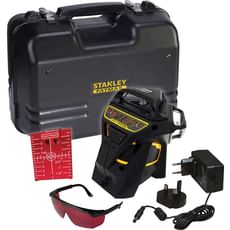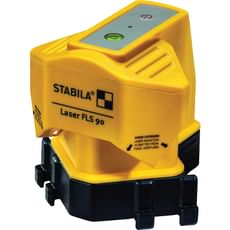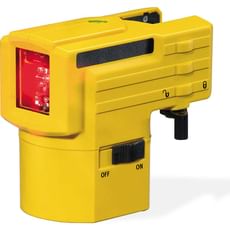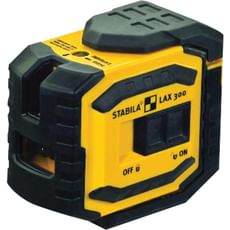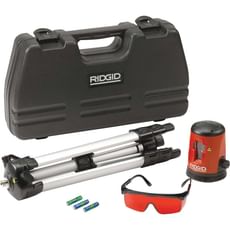Laser Levels & Accessories
Pay in 3 interest-free payments on purchases from £30-2000 with ![]() . Learn more.
. Learn more.
DeWalt DCLE34031 18v Cordless Self Levelling Cross Line GREEN Laser Level
in stock
 Loading...
Loading...
End of content
Error - No more pages to load
About Laser Levels & Accessories
Laser levels have revolutionised the way tradespeople and DIY enthusiasts approach levelling, alignment, and layout tasks across construction, renovation, and installation projects. Whether you're hanging kitchen cabinets, installing suspended ceilings, laying floor tiles, or setting out foundations, laser levels deliver unmatched accuracy and efficiency compared to traditional spirit levels and plumb bobs. Our comprehensive range includes rotary laser levels for large-scale site work, line lasers for interior fitting, dot lasers for precise point transfers, and cross-line lasers that project horizontal and vertical reference lines simultaneously.
Beyond the laser levels themselves, the right accessories are essential for getting the most from your equipment. From clamps and mounts that secure your laser in awkward positions, to detectors and receivers that extend working range outdoors or in bright conditions, each accessory plays a vital role in professional results. Grade rods and target plates improve visibility over distance, whilst laser level glasses enhance beam visibility in challenging lighting conditions. Remote controls allow convenient operation from a distance, particularly valuable when working alone on large sites.
Quality laser levelling equipment represents a sound investment for any tradesperson serious about accuracy and productivity. Modern laser levels from brands like Makita, DeWalt, Bosch, and Milwaukee offer self-levelling technology, IP-rated protection against dust and water, and lithium-ion battery power for cordless convenience. Whether you're a seasoned professional or tackling ambitious home improvements, having the right laser level and supporting accessories ensures work is completed to exacting standards with significantly reduced measuring time.
Jargon Buster
- Self-Levelling: Automatic levelling technology that uses pendulum mechanisms or electronic sensors to establish a true level plane, typically within a range of ±3-5 degrees. If tilted beyond this range, the laser will flash or shut off to prevent inaccurate readings.
- Rotary Laser Level: A laser that projects a 360-degree horizontal or vertical plane by spinning the laser diode at high speed. Ideal for outdoor site work, excavation, and large construction projects where you need a level reference around an entire space.
- Cross-Line Laser: Projects two intersecting laser lines (one horizontal, one vertical) to create a cross pattern on walls and surfaces. Perfect for interior trades like tiling, electrical installation, and carpentry where multiple reference points are needed.
- Laser Receiver/Detector: A handheld device that detects the laser beam, extending the working range significantly beyond what the human eye can see. Essential for outdoor use in bright sunlight or when working over distances exceeding 30 metres.
- IP Rating: Ingress Protection rating indicating resistance to dust and water (e.g., IP54, IP65). The first number rates dust protection (0-6), the second rates water protection (0-8). Higher numbers mean better protection for harsh site conditions.
- Red vs Green Laser: Green lasers are typically more visible to the human eye, especially in bright conditions, but consume more battery power. Red lasers are more economical and sufficient for most indoor applications with adequate visibility.
Who Uses Laser Levels & Accessories?
Laser levels have become indispensable tools across numerous trades and applications:
- Electricians and Sparkys: Setting out level runs for trunking, conduit, switch heights, and lighting installation
- Plumbers and Heating Engineers: Establishing drainage falls, aligning pipework, and setting out bathroom fittings
- Carpenters and Chippies: Kitchen fitting, stud wall installation, door hanging, and skirting board alignment
- Tilers: Setting out tile layouts, ensuring level rows, and maintaining consistent grout lines
- Plasterers and Drylining Specialists: Screeding floors, installing suspended ceilings, and fixing plasterboard
- Groundworks and Civil Engineers: Site levelling, excavation depth control, drainage gradients, and foundation work
- Shopfitters and Interior Designers: Display installation, shelving systems, and partition walls
- Landscape Gardeners: Patio levelling, decking installation, fencing alignment, and drainage planning
- DIY Enthusiasts: Home renovations, picture hanging, shelving installation, and garden projects
How to Choose the Right Laser Levels & Accessories
Selecting the appropriate laser level depends on your specific applications and working environment:
Type of Laser: Dot lasers are ideal for simple plumb and level point transfers. Line lasers project a single horizontal or vertical line for basic alignment tasks. Cross-line lasers provide both horizontal and vertical references simultaneously, perfect for interior trades. Rotary lasers create 360-degree planes and are essential for site work, groundworks, and large-scale projects requiring extended range.
Working Range: Consider the typical distances you'll be working across. Interior line lasers typically offer 10-30 metre range indoors, whilst rotary lasers with receivers can work effectively over 100-500 metres outdoors. If you regularly work on larger sites or in bright conditions, invest in a quality laser receiver to extend usable range significantly.
Self-Levelling vs Manual: Self-levelling lasers dramatically speed up setup and eliminate human error, making them the professional choice for most applications. Manual lasers are more economical but require careful setup with bubble vials and are more suitable for light DIY use or backup equipment.
Power Source: Rechargeable lithium-ion battery-powered models offer cordless convenience and are ideal for sites without mains power. Look for models with decent battery runtime (8+ hours) and consider purchasing spare batteries. Some rotary lasers still use alkaline batteries, which can be advantageous for occasional users who might otherwise face self-discharge issues.
Durability and IP Rating: Construction sites are harsh environments. Look for models with IP54 rating minimum (dust and splash protection), or IP65+ for full dust and water jet protection if working in particularly demanding conditions. Rubber over-moulding and robust cases protect against inevitable knocks and drops.
Essential Accessories: A sturdy tripod or mounting system is virtually essential for most applications. Laser receivers extend range for outdoor work. Laser glasses improve beam visibility in bright conditions. Target plates make the laser more visible over distance. Consider a complete kit that includes mounting options rather than purchasing separately.
Popular Accessories
- Clamps & Mounts: Wall mounts, ceiling brackets, and multi-purpose clamps secure laser levels in position when tripod mounting isn't practical. Magnetic mounts attach to steel beams and metalwork.
- Detectors & Receivers: Extend working range to 100+ metres and enable outdoor use in bright sunlight where the laser beam becomes invisible to the naked eye. Essential for site work and long-distance applications.
- Grade Rods: Telescopic measuring staffs marked with precise graduations that work with laser receivers to measure elevations and depth accurately for excavation and groundworks.
- Laser Level Glasses: Tinted safety glasses that filter ambient light whilst enhancing laser beam visibility, particularly useful with red lasers in bright conditions or when working near windows.
- Target Plates: Reflective plates that make the laser point highly visible over long distances, improving accuracy when transferring points or working with a colleague.
- Remote Controls: Allow convenient operation of laser functions from a distance, particularly valuable when working alone or when the laser is mounted out of easy reach.
- Tripods & Extending Poles: Adjustable tripods provide stable, height-adjustable mounting from floor to ceiling. Extending poles allow ceiling-mounted applications without scaffolding.
- Carry Cases: Protect your investment during transport and storage. Purpose-designed cases with foam inserts keep lasers and accessories organised and protected from impacts.
Safety Information
Whilst laser levels are generally safe when used properly, it's important to observe sensible precautions:
Eye Safety: Never look directly into the laser beam or point it at another person's eyes. Most construction lasers are Class 2 or Class 3R, which are safe under normal use but can cause temporary flash blindness or eye discomfort if viewed directly. Keep lasers away from children and never treat them as toys.
Working at Height: When using lasers on ladders, scaffolding, or elevated platforms, ensure you follow HSE guidelines for working at height. Never over-reach whilst adjusting or reading a laser level. Use appropriate access equipment and maintain three points of contact.
Electrical Safety: Battery-powered models pose minimal electrical risk, but if using mains-powered equipment, ensure leads are in good condition and appropriate for site use. On construction sites, use 110V equipment via a transformer in accordance with UK building site regulations.
Site Awareness: Laser beams can be visible to others on busy sites and may cause distraction. Ensure other workers are aware when you're using laser equipment, and consider whether beam paths might interfere with other activities or machinery operation.
Frequently Asked Questions
What's the difference between a rotary laser and a line laser?
A line laser projects a static laser line (or multiple lines) and is ideal for interior trades like tiling, carpentry, and electrical work, typically with a range of 10-30 metres. A rotary laser spins at high speed to create a 360-degree level plane around an entire room or site, with working ranges extending to 100+ metres when used with a receiver. Rotary lasers are essential for groundworks, site levelling, and large construction projects, whilst line lasers excel at interior fitting and finishing work.
Can I use a laser level outdoors in bright sunlight?
Yes, but you'll need a laser receiver (also called a detector) to detect the beam, as it becomes virtually invisible to the naked eye in bright outdoor conditions. Green lasers are more visible than red in daylight but still require receivers for reliable outdoor work over distance. Most professional rotary lasers are supplied with receivers specifically for outdoor applications. The receiver mounts on a grade rod and emits an audible tone when it detects the laser plane, allowing accurate levelling even in full sunlight.
How accurate are laser levels?
Accuracy varies by model and type, typically expressed as ±X mm per 10 metres. Professional laser levels generally offer accuracy between ±1.5mm and ±3mm at 10 metres, which is more than adequate for most construction applications. Higher-specification models used for precision engineering or large-scale site work may offer ±1mm or better. For context, this level of accuracy far exceeds what's achievable with traditional spirit levels and is sufficient for all standard building work to comply with UK building regulations.
Do I need a green laser or is red sufficient?
For most indoor applications, a red laser is perfectly adequate and more economical, offering better battery life and lower cost. Green lasers are approximately four times more visible to the human eye, making them advantageous for bright conditions, long distances, or outdoor use without a receiver. However, green laser technology is more expensive and consumes significantly more battery power. If you primarily work indoors or will use a receiver for outdoor work, red lasers represent excellent value. Choose green if maximum visibility in challenging conditions justifies the additional investment.
What IP rating do I need for site work?
For typical UK construction sites, look for a minimum IP54 rating, which provides protection against dust ingress and water splashes from any direction. This suits most building sites where the laser may encounter dust and occasional rain. If you regularly work in particularly harsh conditions—heavy rain, very dusty environments, or near water—consider IP65 or higher, which offers complete dust protection and resistance to water jets. Remember that higher IP ratings provide better long-term durability and reliability, protecting your investment against the inevitable knocks and weather exposure of site work.

















